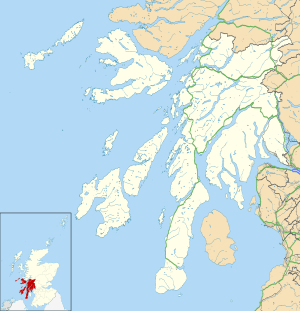Ardfern
Ardfern (Scottish Gaelic: Aird Fheàrna, meaning "the head-land of alder-trees") is a village in Argyll and Bute, Scotland. It lies on the south coast of the Craignish peninsula, facing Loch Craignish.
Ardfern
| |
|---|---|
View of Ardfern, Scotland From the A816 road | |
 Ardfern Location within Argyll and Bute | |
| Population | 400 |
| OS grid reference | NM806043 |
| Council area | |
| Lieutenancy area | |
| Country | Scotland |
| Sovereign state | United Kingdom |
| Post town | LOCHGILPHEAD |
| Postcode district | PA31 |
| Police | Scotland |
| Fire | Scottish |
| Ambulance | Scottish |
| UK Parliament | |
| Scottish Parliament | |
It has a small, close community, and features a church, fire station, primary school, craft centre with a tea room, a village shop, public house (The Galley of Lorne), and yacht centre. .
It lies between the towns of Oban to the north and Lochgilphead to the south. On the east side of the Craignish Peninsula is Nether Lorne, Argyll.
The population is approximately 400 of year-round residents, with many more during the holiday season.
Village services
Ardfern has a pub called The Galley Of Lorne it also has a café that recently opened (2020) and a village store (which previously had a post office).
Brief history
There is evidence of habitation going back to pre-history. Contemporaries of St. Columba settled by 600 AD and the earliest church on the peninsula, Kilvaree, now a ruin, is 12th century or earlier.
After 1778, when most of the peninsula was in the ownership of the Campbells of Craignish, who had been the dominant local clan since the earliest recorded times around 1100, parcels of land were gradually sold off, and by 1850 most of the land was part of two estates; Lunga, purchased by the MacDougalls (of Lunga island), to the north and the Craignish estate to the south end of the peninsula. This division essentially remains the same today, though in 1983 a part of the Lunga estate was sold off to a developer to create Craobh Haven, a marina and village created in and around a natural harbour on the west side of the peninsula.
Until modern times farming was the main occupation and cattle from the off lying islands, Jura, Scarba, etc., were landed near Craignish point and driven along the peninsula to the mainland proper. Of the three inns that ‘supported’ the drovers only one, dating from the 17th – or even 16th century - now called the Galley of Lorne, survives in Ardfern. Farming, together with a busy weaving industry and three mills, carried on during the first part of the twentieth century. During the 2nd World War, German U boats would come alongside the back of the Island in the dark and take the wild goats as fresh meat for the crews.
The latter half of the twentieth century saw farming and traditional industry decline and the population fell to less than half its now 400+. The current Laird of Lunga, Colin Lindsay-MacDougall, saw that for the community to survive, things must change. To re-vitalise the area, he created a yacht centre at Ardfern to attract the ever-increasing numbers of cruising yachtsmen on the west coast ; re-opened and developed the old Inn (the Galley of Lorne), sold housing plots to attract people into the area, encouraged artists of all sorts and the trades-people necessary for a thriving community, to stay on his estate.
Ardfern today has a diverse and growing population. The school is thriving. The Yacht Centre, together with the new marina at Craobh Haven, harbours the largest fleet of cruising yachts on the west coast. Tourism and related businesses bring much income to the village, but there are many other small enterprises ; artists, musicians, sculptors, craftsmen and women, horticulturalists, filmmakers, writers, computer based businesses, some of which are recognised internationally, and mail order businesses. There are plumbers, stonemasons, builders, joiners, furniture-makers, gardeners and horticulturists, woodworkers, electricians and many more. Ardfern is an isolated community, 16 miles (26 km) from the nearest small town, Lochgilphead (pop circa 3,000), which is the administrative centre of Argyll & Bute.
In the last ten years or so more houses have been built, bringing a wider group of people to the village. Many commute to Oban or Lochgilphead, or even further afield.
Craignish Village Hall
By 1997 the old village hall was inadequate and crumbling. A new one was required and fundraising started. By 2004 enough had been raised to begin the project. In autumn 2005, the new hall was opened.
The full cost of £600,000 was raised by a small and very focused committee, all resident on the Craignish peninsula. Significant amounts of money, expertise and work were given by local people and businesses.
With full, computerised, professional-quality theatre light and sound systems, and versatile stage, the hall attracts touring theatre groups, performing artists and musicians from Scotland, the UK, Europe and beyond and audiences from all of Argyll and further afield.
The local council for Ardfern is the Craignish Community Council, they meet once every 2 months at the Craignish Village Hall.[1]
External links
| Wikimedia Commons has media related to Ardfern. |